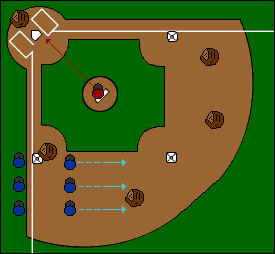Baseball Drills: Baserunning: Delayed Steal
Drill: Delayed Steal
Purpose:
Develop base runners ability to master the timing required to perform a delayed steal.
Equipment:
Baseballs, catchers in gear, batting helmets
Setup:
Have a complete infield including a couple of catchers in gear. Coach or any pitcher can pitch. Have the rest of the team with helmets on to run the bases. You don't need a hitter.
Execution:
In this drill have three lines at first base with the first runner at first and the other two lines spaced out slightly behind. See graphic below.
If you are not familar with coaching a delayed steal, please see our Delayed Steal Instruction page.
Runners will take their normal lead off first base. As the pitcher begins their delivery the runner will take their normal secondary lead. The goal is to make everything look like a normal secondary lead. Often players will alert the opposing team by being much more agressive then normal on the secondary lead. It should look the same. This is a timing play that you'll call based on watching the opposing team. So you don't want the player to alert the team that they are running by being more aggressive than normal.
After the pitch crosses home plate the player will take one more shuffle step and then take off for second base. So the timing is to give the catcher and other players a split second to start doing what they normally do (not paying attention) before taking of.
Having the three lines of players go at once is good reinforcement for the players and for the coach that the timing is correct. They should be finishing their secondary lead at the same time and going at the same time.
After the players run to second, have them stay there and when the entire team is there perform the same drill from second base.
For Little League this drill needs to be modified as you don't want it to look like a straight steal. Normally there is something the team is doing after the ball is caught by the catcher and that is what you're taking advantage of. Going too soon will take away that advantage.
Try setting up the scenerios described in the Delayed Steal Instruction page. So if a catcher drops to his knees to toss the ball back to the pitcher, the timing should be when he starts dropping to his knees. Or if he frames the pitch and stares at his glove the timing would be to take off right when he starts framing the pitch. If the infielders are the key, then it may take a second or two before the runner should go. In this way the delayed steal in Little League is more difficult than at other levels, but it can still be effective based on the situation. For this reason you may not want to try this until they get to the minor or major level.

Most Recent Blog Posts
Working With Players on Focusing on the Correct Part of the Baseball when Hitting (October 15 2016)
Getting More Accurate Throws From Your Team (April 5 2016)
Thank you for all of your great coaching skills, drills, and education it means a lot to us youth coaches!!!
- Chris W.







